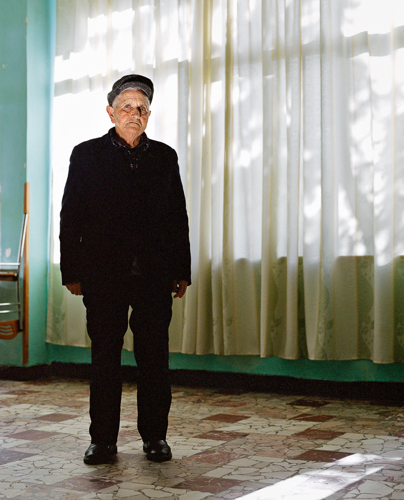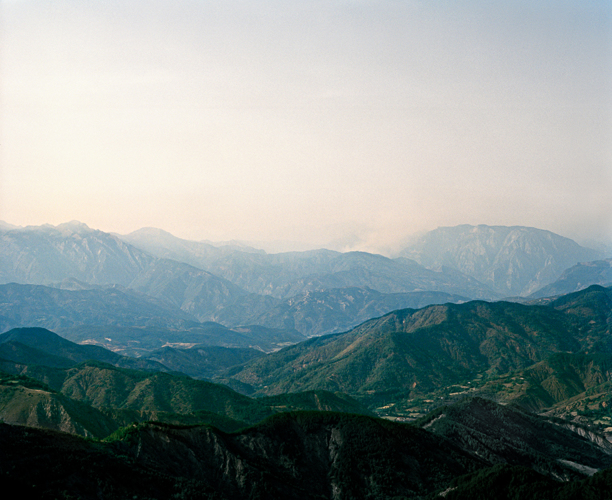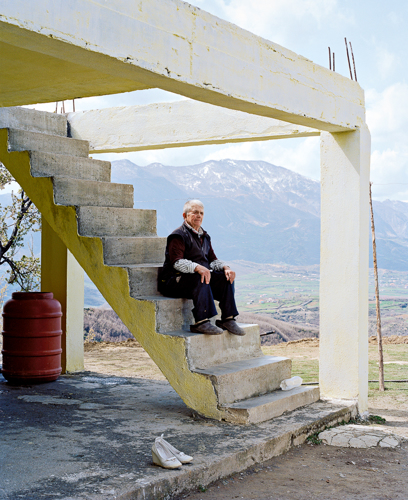-

HAKIJE (59)
Hakije was brought up as a boy from birth, because a dervish had prophesied that her parents would have a son. She grew up in a remote village near the Kosovo border, where five other man-women lived. She still lives in her childhood home, alone and withdrawn, and tends the dervish’s final resting place.
-

-

QAMILE (86)
Qamile was the youngest of nine girls and was already spending her time with the men of the village at the age of nine. From that moment on, she grew up as a son. As the only man in the family, she inherited her childhood home after her parents died. She was known as “Grandpa Qamile,” but over the years, the woman inside her resurfaced. Her movements became more graceful, her features softer. Qamile died in 2011.
-

-

-

SHKURTAN (76)
Shkurtan says that she decided to become a man at the age of 6 in order to tend the animals and to be able to go anywhere she wanted. Shkurtan has a twin sister, two other sisters and a brother – she wanted to be free as he was. As children, she and her siblings admired a Burrnesha who lived in the neighborhood for her will and strength.
-

-

ILMIJE (30)
Ilmije wanted to be free and independent. In the northern part of the country, only boys are allowed to leave home and spend the summer in the mountains with the flocks. So, after the death of her mother, she decided to lead the rest of her life as a man. Ever since then, she has been in charge of her father’s household, while also enjoying the liberties that come with the male role.
-

-

QJUSTE (66)
Qjuste had an arranged marriage and gave birth to a child. Six months later, she got a divorce. To prevent her son from losing his honor and being stamped the son of a whore, she swore her oath as man-woman. She is a single parent, owns a café and a tire repair shop, and has built a large, luxurious house for herself. As a woman, she would never have been able to achieve such affluence.
-

-

RAHIME (66)
Rahime is called “Uncle” by the younger members of her family. She felt that it was an honor to provide for her family after the death of her brother and became a Burrnesha at the age of 25. She swore the oath to always remain a virgin and to take on a man’s responsibilities.
-

-

-

OSMANI (80)
Osmani doesn’t remember when she became a man. She had to take care of her sick parents at an early age. Already as a child, she spent months with the other men and their flocks up in the mountains. Later, she worked in an ore mine. She has never learned to read and write.
-

-

SANIJE (50)
Sanije never liked to dress like a girl. Since her father died young, the two oldest children had to earn a living for the family. So she took the oath at the age of 14 to lead the life of a man. As she gets older, she is beginning to have some doubts. She will have no children to care for her when she is old and gray. If times had been different, she would have perhaps chosen a different path.
-

-

SAMI (84)
Sami was told at the age of 7 that she was her father’s son. Her mother took her to the city to buy boy’s clothing. When she reached marriageable age, she regretted her fate for a short time. She was very pretty, but because of the gun she always carried, no one dared to approach her.
-

-

DRANDE (53)
Drande burned all her girl clothes after eighth grade and swore her oath as man-woman at the age of 19, following the death of her father. As a child, she lost her hands while playing with a hand grenade left over from the Albanian civil war. The male role makes it easier for her to deal with her physical disability. “No one wants a woman without hands,” she says.
-

-

-

DIANA (54)
Diana has lived as a man since she was 17 years old. She did not want to accept that men are allowed to do everything and women are not. She likes to tell of how she rose to the rank of general in the army under the Communist regime of dictator Enver Hoxha. Later, she worked as a security guard in the port of Durrës. Diana is open-minded and cosmopolitan, a genuine urbanite. The only thing she does not like to talk about is her feelings, since this would damage her reputation as a man.
-

Pepa Hristova
Sworn Virgins
Albania 2008 - 2010
In northern Albania, in the Accursed Mountains, said to have been created by the devil himself, the tradition of the sworn virgins, the last man-women of Europe, is still alive to this day. The Kanun, a collection of laws from the Middle Ages, passed on for generations by word of mouth, permits families to replace the male head of the household with a woman in the case of the patriarch’s death, often brought about by clan-related blood feuds. Yet the woman’s new status requires her to make an irrevocable vow to preserve her virginity for the rest of her life. Adult women may swear this oath to take the place of the deceased father or brother. But even newborn girls can be declared sons and raised as boys for the purpose of providing the family with a male heir. Occasionally, women also take the vow to escape a prearranged marriage. Filling the roles of men, these women can also expect to gain more recognition in the male-dominated society of Albania.These so-called oath-virgins, or Burrnesha, not only receive the status but also the rights of men and are highly respected in the family. They do men’s work, and dress and behave like men. But they are men in a social, rather than in a sexual sense. The sworn virgins adapt their roles so perfectly that, over time, they are no longer recognized as women outside of their family. Over the years, the woman in them is lost.
Photographer Pepa Hristova was born in 1977 in Bulgaria. She studied communication design at the Hamburg University of Applied Sciences. Her photographic work is driven by her fascination with the fractured beauty of the east and her interest in social phenomena and archaic traditions, leading to an examination of the unknown, changing side of Europe. She focuses on the alienation of Muslims in orthodox Bulgaria, documents a centuries-old custom in North Albania with ‘Sworn Virgins’ or looks behind the closed doors of Bulgarian children’s homes. She approaches her subjects with intuition and emotion and experiments with different genres and the ambiguity of photographic imagery. Snapshots combine with staged images and precise observations of situations, opening up an associative space, in which there is still scope for individual interpretations and points of contact. Hristova received multiple fellowships and awards including the C/O Berlin Talents Award (2008), the Otto Steinert Award for subjective photography (2009), a fellowship from the Berlin Academy of Arts, and the Border Crossers grant of the Robert Bosch Stiftung (2010). Her work has been on display at House Of Photography Deichtorhallen Hamburg, C/O Berlin, the Berlin Academy of Arts, Bozar Centre for Fine Arts Brussels and elsewhere.

























